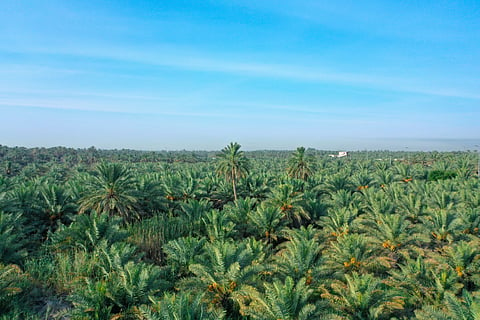
- Destinations
- Experiences
- Stay
- What's new
- Celebrating People
- Responsible Tourism
- CampaignsCampaigns
- Subscribe
- Buy Now

Located in Saudi Arabia's Eastern Province, Al-Ahsa Oasis speaks volumes of the tenacity and inventiveness of people. With more than 2.5 million date palms spanning over 85.4 sq km, it is known as the largest palm oasis in the world—that too in a country that is often perceived as a desert nation!
For thousands of years, civilisation, agriculture and culture have all flourished in this singularly lush area in the middle of the dry desert. Outlook Traveller takes a closer look to see what makes this destination a unique place to visit in Saudi Arabia.
The deserts of Ad-Dahna to the west and the Rub' al Khali (Empty Quarter) to the south enclose Al-Ahsa Oasis, which is located roughly 60 km inland from the Persian Gulf. The oasis is made up of 22 villages and four major cities, including Al-Hofuf and Al-Mubarraz. Rainwater can gather and form a large aquifer due to the impermeable layer beneath the sand, which is part of its unique geological formation. The region's rich vegetation and agriculture are supported by this natural reservoir, which supplies water to more than 280 artesian springs.
In 2018, UNESCO World Heritage Site inducted Al-Ahsa Oasis as "Al-Ahsa Oasis, an Evolving Cultural Landscape." The distinction recognises the oasis as a symbol of the relationship between the environment and people over time. Twelve elements make up the site, including gardens, canals, wells, springs, a drainage lake, historic structures, the urban fabric, and archaeological sites.
Owing to the area’s plentiful water resources, Al-Ahsa has a prehistoric past and indications of human occupation. The Dilmun civilisation, which is said to have started in the Eastern Arabian oases, was one of the many civilisations that have called the oasis home. Numerous civilisations and rulers have influenced Al-Ahsa over the ages, adding to its diverse cultural fabric.
A flourishing agricultural industry, mainly recognised for its date production, is supported by the lush lands of Al-Ahsa. More than 2.5 million date palms grow in the oasis, yielding more than 1,00,000 tonnes of dates a year. The Khalasah date, regarded as one of the best in the world, is the region's most well-known product.
The oasis makes a substantial contribution to Saudi Arabia's other food output, too, by growing rice, maize, citrus fruits, and other crops in addition to dates.
Al-Ahsa's proximity to the Ghawar well, the largest conventional oil well in the world, makes it an important part of Saudi Arabia's economy in addition to its agricultural sector. The 1938 discovery of petroleum close to Dammam sped up the area's development.
Al-Ahsa is now home to a number of enterprises, such as the production of cement, plastics, and traditional crafts. Infrastructure improvements that improve trade and travel, like the road that was finished in 2021 and connects Oman and Saudi Arabia through the Empty Quarter, also help the region.
Al-Ahsa is home to numerous architectural and cultural landmarks. The Jawatha Mosque, which is around 12 km northeast of Hofuf, is one of them. Constructed in the 7th century and renovated in 2007, it is among the oldest mosques in eastern Arabia.
Another important location is Qasr Ibrahim, a historic palace made of indigenous materials like mud combined with straw and palm trunks that combines Islamic and military architectural styles.
Al-Ahsa has become a well-known travel destination, thanks to its historical landmarks, cultural legacy, and scenic surroundings. The oasis' dedication to fostering innovation and cultural diversity is demonstrated by its 2015 admission to the UNESCO Creative Cities Network. The Al-Asfar Lake, ancient marketplaces, and the charming palm grove and spring scenery are just a few of the attractions available to tourists.
